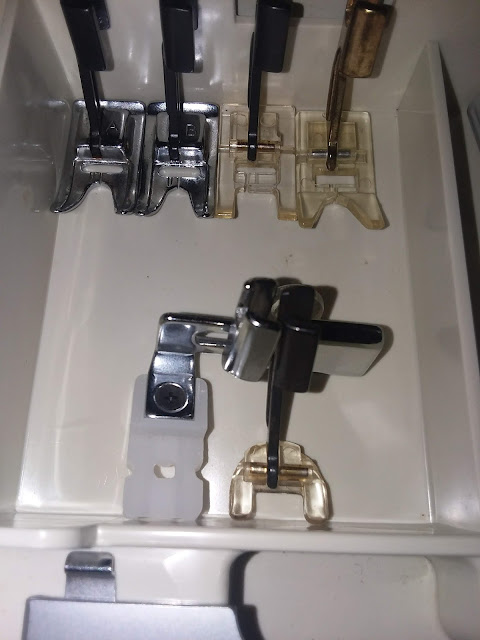How to Identify Kenmore Left Homing presser feet and Center Homing presser feet
It can be difficult to identify Kenmore sewing machine presser feet, because most of them are NOT labeled with a part number. The super high shank presser feet are the hardest for most people to find, especially if they don't know the difference between left homing needle presser feet, versus center homing presser feet.
I discovered that Kenmore put a convenient "sighting line" on their presser feet, which help you identify these feet correctly, at least the zigzag feet, that is! A "sighting line" is engraved in the front of the presser foot, to assist you in sewing along your seam line, but many home sewers are never taught to use a sighting line, and don't know what it is, or why it is there. It is specifically engraved IN FRONT OF THE NEEDLE POSITION FOR STRAIGHT STITCHING, which makes it so much easier to sew a straighter seamline, once you know that is what it is for! (You may not believe it, but I didn't discover this about Kenmore feet, until I had owned and refurbished many of them, and began collecting the accessories for them, and needed to get them with the correct machines!)
Tomi Russel (she says it is not complete, but is a great start!) made this list of center homing needle SHS models with Center homing needles:
"158.14000, 158.1601, 158.16011, 158.16012, 158.16013, 158.16020, 158.16021, 158.16250, 158.16410, 158.1680, 158.16801, 158.16820, 158.16900, 158.17600, 158.17651, 158.17812, 158.17820, 158.17821, 158.17830, 158.17840, 158.17841, 158.17891, 158.17892, 158.1800, 158.19310, 158.19311, 158.19312, 158.19411, 158.19412"
NOTE- At the bottom of this post, look at the Sears 1977 Summer catalog, the illustrations, in the upper right corner, clearly show these details about the presser feet for the various left, or center homing needle machines! Proof this isn't just my opinion, lol!
I started taking photos to help illustrate this, but at least with my cell phone camera, it can be difficult to get good enough photos to show the engraved sighting line, versus the cut in the presser foot, to allow the thread to get through to the needle opening, because in photos, the engraved groove, actually shows up BETTER than the cut opening! I literally have to look at the photos on my computer screen, to make them big enough to identify them, correctly, when labelling them for sharing!
 |
| Kenmore 1931 Super High Shank CENTER HOMING Presser Foot A and Straight Stitch presser foot |
 |
| Kenmore Super High Shank overlock presser foot is the same for left homing and center homing machines |
 |
| CENTER HOMING NEEDLE feet model 1931 Shirring foot, B zigzag satin stitch foot, C clear zigzag, D clear zigzag satin stitch foot |
 |
| LEFT HOMING NEEDLE presser feet Kenmore 1803 A, B, C, Q feet Adjustable zigzag, monogrammer foot |
 |
| LEFT HOMING NEEDLE presser feet Kenmore 1803 |
 |
| These feet are for both left and center homing needle machines ooveredge /overlock foot, cording foot Shirring foot, applique foot |
 |
| Notice the illustration in the upper right corner, for left homing needle feet, versus center homing needle feet, points out these feet details in the 1977 Summer catalog |
Some early Kenmore sewing machines, manufactured by White, have top mounting presser feet, usually on early models, which also used a friction pulley, instead of a belt, to drive the machine These were usually straight stitch only models, but zigzaggers and blind hemmer attachments for them, were available.









